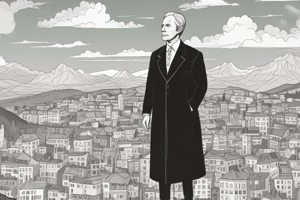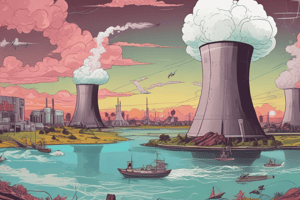Podcast
Questions and Answers
What is the primary motivation behind the EU's leadership ambition in international climate policy?
What is the primary motivation behind the EU's leadership ambition in international climate policy?
- To fill the leadership vacuum created by the US's withdrawal
- To address the environmental problem of climate change
- To project itself as a united leader on the international political scene (correct)
- To promote economic growth through environmental incentives
What was the outcome of the 1992 Maastricht Treaty on environmental policy?
What was the outcome of the 1992 Maastricht Treaty on environmental policy?
- It implied a shift in sovereignty away from separate member states (correct)
- It created a new international regime for climate governance
- It led to the decentralization of environmental policy to individual member states
- It resulted in the EU taking a more active role in international climate negotiations
What is the key difference between a 'pusher' and a leader in the context of international environmental regimes?
What is the key difference between a 'pusher' and a leader in the context of international environmental regimes?
- A pusher is a country, while a leader is an individual.
- A pusher is more focused on environmental issues, while a leader is focused on economic growth.
- A pusher is a follower, while a leader is a negotiator.
- A pusher advocates for strong joint commitments, while a leader influences a group to adopt a particular line of policy. (correct)
Why did the EU choose to take a leading role in international climate policy despite the economic and environmental incentives for remaining Annex I countries to go alone being weak?
Why did the EU choose to take a leading role in international climate policy despite the economic and environmental incentives for remaining Annex I countries to go alone being weak?
According to the Blackwell Encyclopedia of Political Science, what is the definition of leadership?
According to the Blackwell Encyclopedia of Political Science, what is the definition of leadership?
What was one cause of the EU's inability to play a leadership role in the making of the Climate Convention?
What was one cause of the EU's inability to play a leadership role in the making of the Climate Convention?
What is the primary challenge to international cooperation on climate change according to Hypothesis 1 and 2?
What is the primary challenge to international cooperation on climate change according to Hypothesis 1 and 2?
What was the notable exception to the EU's lack of leadership in the climate negotiations between 1992 and 1997?
What was the notable exception to the EU's lack of leadership in the climate negotiations between 1992 and 1997?
How can EU climate policy be understood in a strategic policy perspective?
How can EU climate policy be understood in a strategic policy perspective?
What was removed as an obstacle to EU leadership in the climate negotiations in 1997?
What was removed as an obstacle to EU leadership in the climate negotiations in 1997?
What is the regime theory perspective on international cooperation on climate change?
What is the regime theory perspective on international cooperation on climate change?
What is the free riding problem in the context of international climate cooperation?
What is the free riding problem in the context of international climate cooperation?
What is implied by the concept of 'free riding' in the context of international cooperation?
What is implied by the concept of 'free riding' in the context of international cooperation?
What is the significance of institutional momentum in the context of international environmental regimes?
What is the significance of institutional momentum in the context of international environmental regimes?
What is the implication of the US exit in 2001 for the EU's leadership ambition?
What is the implication of the US exit in 2001 for the EU's leadership ambition?
What is the main difference between regime theory and neorealism in the context of international cooperation?
What is the main difference between regime theory and neorealism in the context of international cooperation?
What opportunity did climate change negotiations provide for the European Union?
What opportunity did climate change negotiations provide for the European Union?
What was the perception of the EU by the media, general public, and environmental NGOs?
What was the perception of the EU by the media, general public, and environmental NGOs?
What was the reason for the EU's limited leadership capability during the initial phase of climate negotiations?
What was the reason for the EU's limited leadership capability during the initial phase of climate negotiations?
What was the effect of the EU Commission's proposal for a carbon/energy tax?
What was the effect of the EU Commission's proposal for a carbon/energy tax?
What was the main characteristic feature of EU climate policy before 1997?
What was the main characteristic feature of EU climate policy before 1997?
What was Germany's aim in reducing GHG emissions by 2000?
What was Germany's aim in reducing GHG emissions by 2000?
What was the external effect of the EU's internal controversy over climate policy?
What was the external effect of the EU's internal controversy over climate policy?
What was the EU's leadership ambition during the initial phase of climate negotiations?
What was the EU's leadership ambition during the initial phase of climate negotiations?
What is the underlying motivation for the EU's ambition to be a global leader in international climate policy?
What is the underlying motivation for the EU's ambition to be a global leader in international climate policy?
What is a key challenge to international cooperation on climate change?
What is a key challenge to international cooperation on climate change?
What is the relationship between the EU's international ambitions and its internal cohesion?
What is the relationship between the EU's international ambitions and its internal cohesion?
What motivates the EU to take a united stance on environmental policy?
What motivates the EU to take a united stance on environmental policy?
What is the significance of the Maastricht Treaty in the context of EU environmental policy?
What is the significance of the Maastricht Treaty in the context of EU environmental policy?
How does regime theory relate to international cooperation on climate change?
How does regime theory relate to international cooperation on climate change?
What is the significance of the 1990s in the context of EU international ambition?
What is the significance of the 1990s in the context of EU international ambition?
What is the relationship between EU leadership ambition and internal institutional cohesion?
What is the relationship between EU leadership ambition and internal institutional cohesion?
What was the outcome of the EU's internal burden-sharing agreement for the 15% reduction of three GHGs by 2010?
What was the outcome of the EU's internal burden-sharing agreement for the 15% reduction of three GHGs by 2010?
Which country demonstrated instrumental leadership during the Kyoto negotiations?
Which country demonstrated instrumental leadership during the Kyoto negotiations?
What was the characteristic of EU decision-making during the Kyoto negotiations?
What was the characteristic of EU decision-making during the Kyoto negotiations?
What was the outcome of the EU's efforts to protect the environmental integrity of the Kyoto Protocol?
What was the outcome of the EU's efforts to protect the environmental integrity of the Kyoto Protocol?
What was the consequence of the EU's conflict with the US-led Umbrella Group?
What was the consequence of the EU's conflict with the US-led Umbrella Group?
What was the EU's leadership role in international climate policy before the US withdrawal from the Kyoto agreement?
What was the EU's leadership role in international climate policy before the US withdrawal from the Kyoto agreement?
What was the EU's ambition in terms of climate policy?
What was the EU's ambition in terms of climate policy?
What can be inferred about the EU's role in international climate policy during the Kyoto negotiations?
What can be inferred about the EU's role in international climate policy during the Kyoto negotiations?
Study Notes
The EU's Leadership Ambition in Climate Policy
- The EU attempted to play a lead role in the drive for international regulatory policies to reduce GHG emissions, particularly after the US exit in 2001.
- The EU saw the climate issue as an opportunity to project itself as a united leader on the international political scene and to develop its "foreign policy."
The EU's Climate Policy and Leadership
- The EU adopted a stabilization target in October 1990, with some member states (e.g., Germany) aiming for a 25% reduction of GHGs by 2000.
- The EU's leadership ambition was hindered by internal controversy over its climate policy, particularly the carbon/energy tax proposal.
- The EU's external performance in the climate process was passive and not very innovative due to internal strife.
The EU's Role in the Climate Negotiations
- The EU's pusher image was sustained, but it provided little leadership during the initial phase of climate negotiations.
- The EU's internal burden-sharing agreement gave it more credibility internationally, but its leadership role was uncertain due to modest economic costs.
- The US demonstrated instrumental leadership during the Kyoto negotiations, and the EU spent most of its time negotiating with itself.
The EU's Post-Kyoto Performance
- The EU failed to present a single proposal at COP 4 in Buenos Aires in 1998 due to internal strife.
- The EU fought to protect the environmental integrity of the Kyoto Protocol, particularly by proposing a cap on emissions trading and minimizing the admission of using sinks as a climate measure.
- The EU's positions generated a strong conflict with the US-led Umbrella Group, leading to the breakdown of the 6th Session of the Conference of the Parties in The Hague in 2000.
The EU's Institutional and Political Cohesion
- The EU's efforts to develop a coherent climate policy were influenced by its internal institutional and political changes, such as the development towards European integration and the 1992 Single European Market.
- The Maastricht Treaty implied a shift in sovereignty away from separate member states in several issue areas, including environmental policy.
- The EU needed to secure greater internal institutional and political cohesion to fulfill its ambitions as a credible global actor.
Studying That Suits You
Use AI to generate personalized quizzes and flashcards to suit your learning preferences.
Related Documents
Description
Explore the role of the European Union in climate politics and its leadership ambition in the climate process. Learn about the economic and environmental incentives behind the EU's climate actions.




